Perennial flowers are a great choice for gardens because they produce wonderful blooms that come back year after year. Unlike annuals, you do not have to plan ahead for next year’s landscape. Choosing hardy perennials means less work for you, and more time to sit back and enjoy the gorgeous garden show from spring to fall. And sometimes selecting tender perennials is worth it for the extremely showy blooms.
Pink is a favorite color for the garden. Pink contrasts against the green foliage, and compliments other color favorites such as yellow and purple. It is also a color of happiness and affection, bringing a sense of warmth to any landscape.
Here in this guide, we have chosen a selection of pink perennial flowers. To ensure there is a flower for every garden, we have chosen flowers with different plant zones, sun and soil requirements, and heights. So, let’s take a closer look at our favorite pretty-in-pink perennials.
Angel’s Fishing Rod
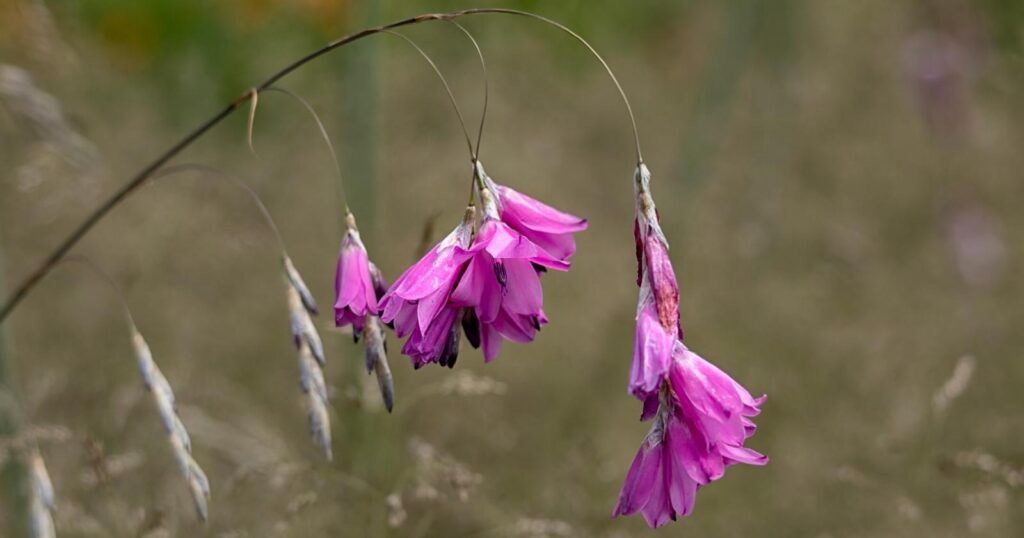
Scientific Name: Dierama pulcherriumum
- Sun Exposure: Full sun
- Height When Mature: 2 – 5 feet
- Soil pH: Acid, Alkaline, Neutral
- Plant Zone: 7 – 10
Angel’s Fishing Rod is an elegant perennial flower native to South Africa. Its arching stems carry bell-shaped pale pink to vibrant magenta blooms that droop downwards. It blooms all summer long, overhanging the grass-like foliage that is evergreen in warmer climates.
This flower likes humus-rich, well-drained soils. It withstands windy and salty air, making it ideal for coastal areas. This flower looks great hanging over slopes, ponds, or low walls. It is a low-maintenance plant that doesn’t like too much water.
Baneberry
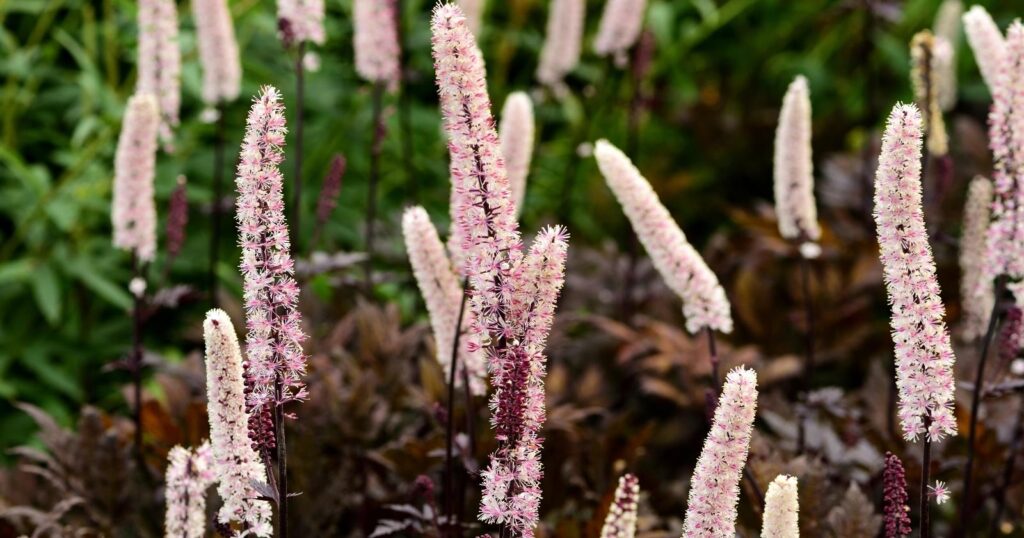
Scientific Name: Actaea simplex
- Sun Exposure: Partial sun, shade
- Height When Mature: Up to 5 feet
- Soil pH: Acid, Alkaline, Neutral
- Plant Zone: 4 – 8
This perennial flower is an easy-going option with stunning blooms that last all summer long into fall. Baneberry prefers averagely moist, well-drained soil. Its height and dark foliage make it a great option for the back of your bed, providing a contrasting background for other flowers.
‘Pink Spike’ is a beautiful pink species. The foliage is almost as striking as the flower, which is a rich chocolate-purple color. This gives way to arching stems that are adorned with intensely fragrant pink flowers. They bud in bright raspberry pink that bloom into a paler hue.
Bee Balm
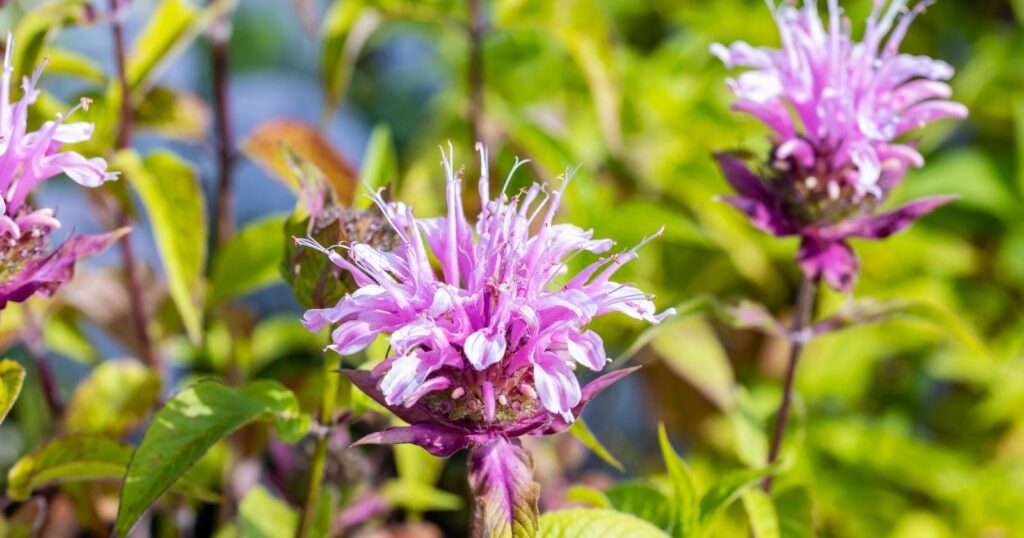
Scientific Name: Monarda
- Sun Exposure: Full sun, partial sun
- Height When Mature: Up to 4 feet
- Soil pH: Acid, Alkaline, Neutral
- Plant Zone: 4 – 9
There are many Bee Balm species to choose from. Exceptionally beautiful pink options include ‘Pardon My Pink’, ‘Gardenview Scarlet’, and ‘Kardinal’. It’s important to choose the right Bee Balm for your landscape as their height ranges from 8 inches to 4 feet tall.
Bee Balm is also commonly called Bergamot because the fragrant foliage is similar to bergamot orange. This perennial flower attracts scores of pollinating insects and hummingbirds. It is a relatively easy-going plant just as long as the soil is kept evenly moist.
Bleeding Heart
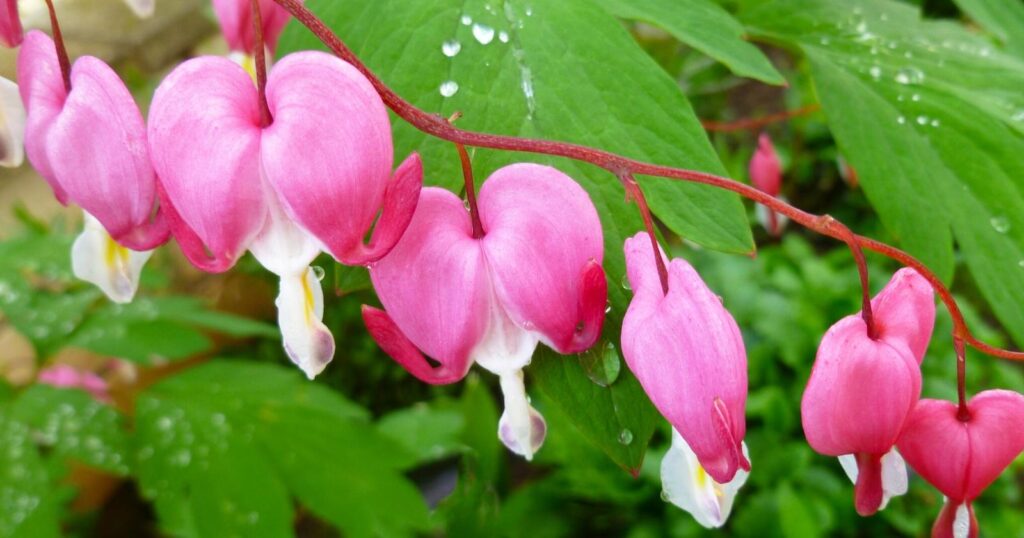
Scientific Name: Dicentra spectabilis
- Sun Exposure: Partial sun
- Height When Mature: 2 – 3 feet
- Soil pH: Alkaline, Neutral
- Plant Zone: 3 – 9
Bleeding Heart is one of the most stunning perennial flowers. Its gracefully arching stems carry little pink hearts with a protruding white petal. It blooms in the late spring for several weeks, and it is an old garden favorite. The bloom time can be extended into the fall if watered well.
Bleeding Hearts require partial shade and do great in woodland borders or under taller plants or trees where other flowers would struggle. They are toxic to animals and humans if ingested, and the foliage can irritate sensitive skin.
Candle Larkspur
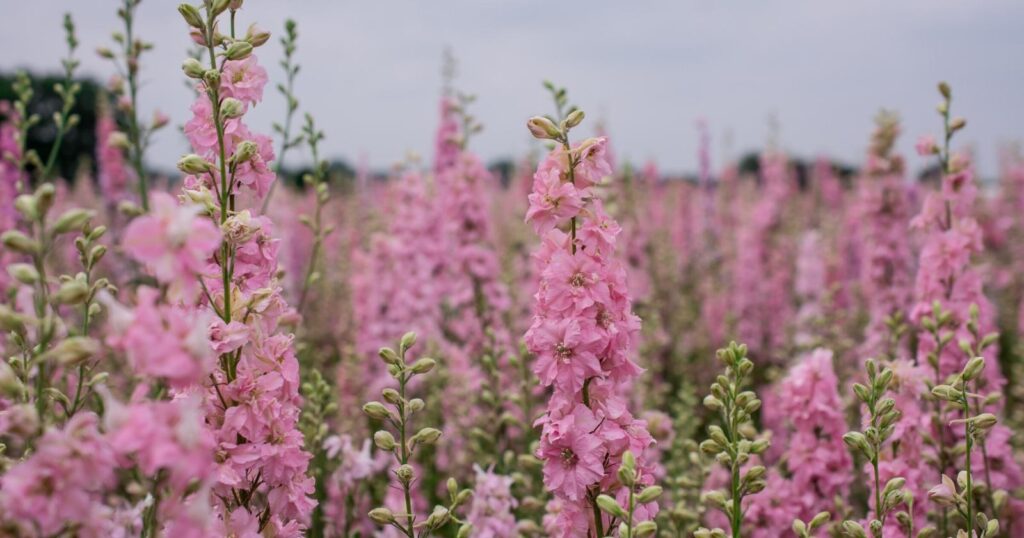
Scientific Name: Delphinium
- Sun Exposure: Full sun, partial sun
- Height When Mature: 3 – 5 feet
- Soil pH: Acid, Alkaline, Neutral
- Plant Zone: 3 – 7
There are many species of Delphinium. ‘Pink Punch’ is a striking perennial flower that stands out from the crowd. The strong spikes carry frilly pink blooms, densely packed for an intense pink punch. It blooms for several weeks from early summer through to fall. Its tall presence makes it an ideal runner for the back of the garden.
Candle Larkspur requires a sheltered spot to protect it from strong winds. Plus, it prefers medium moisture, well-drained soils. Again, butterflies and hummingbirds cannot resist this tall pink beauty.
Chives
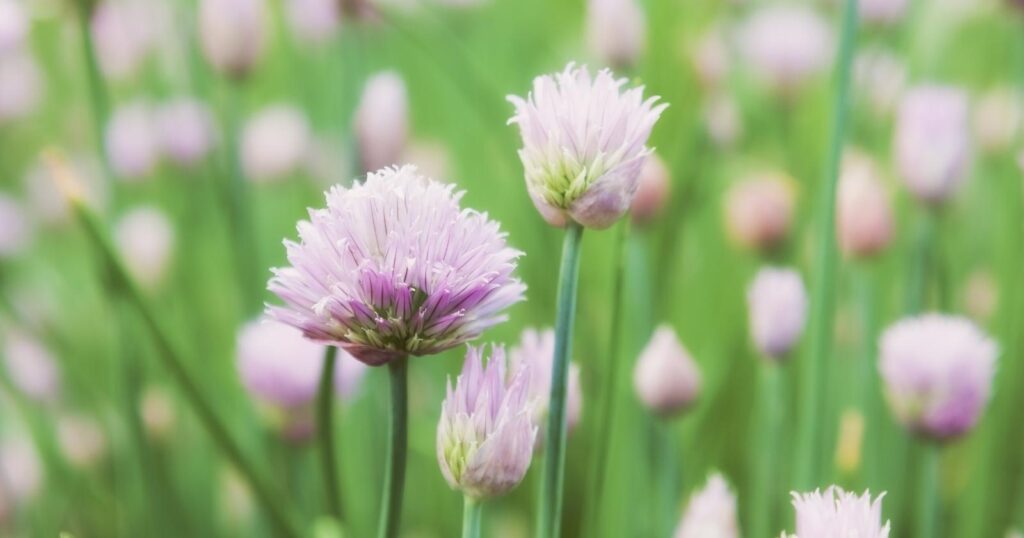
Scientific Name: Allium schoenoprasum
- Sun Exposure: Full sun, partial sun
- Height When Mature: 1 – 2 feet
- Soil pH: Acid, Alkaline, Neutral
- Plant Zone: 3 – 9
If you’re looking for an edible pink perennial, look no further than this pick. Both the blooms and the leaves are edible. It is a small flower that looks great in the front of beds, in herb gardens, rockeries, or in containers. The umbels rise above the grass-like foliage and are pale pink.
Chives are a low-maintenance option that thrives in fertile, well-drained soils. It is a fragrant pick that keeps deer away, but it attracts bees and butterflies. It will self-seed easily if not deadheaded.
Chrysanthemum
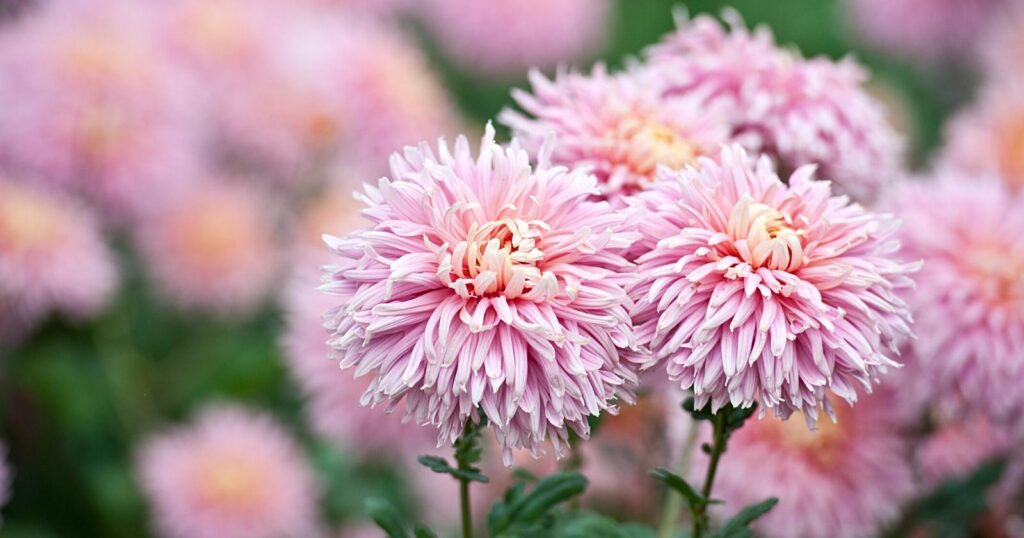
Scientific Name: Chrysanthemum
- Sun Exposure: Full sun
- Height When Mature: 1 – 2 feet
- Soil pH: Acid, Alkaline, Neutral
- Plant Zone: 5 – 9
Nothing screams garden staple more than a Chrysanthemum. Chrysanthemum ‘Grandchild’ is an award-winning popular pink variety that is a hardy perennial. When all other flowers are beginning to fade, this mum produces large double blooms in the fall.
Mums are easy to grow, the only love it requires is to pinch out the growing tip to encourage better blooms. Mums are perennials that need full sun and rich, well-drained soil to thrive. It is toxic to dogs, cats, and horses, making it one to carefully consider for your space if you have a naughty pet digger.
Clematis
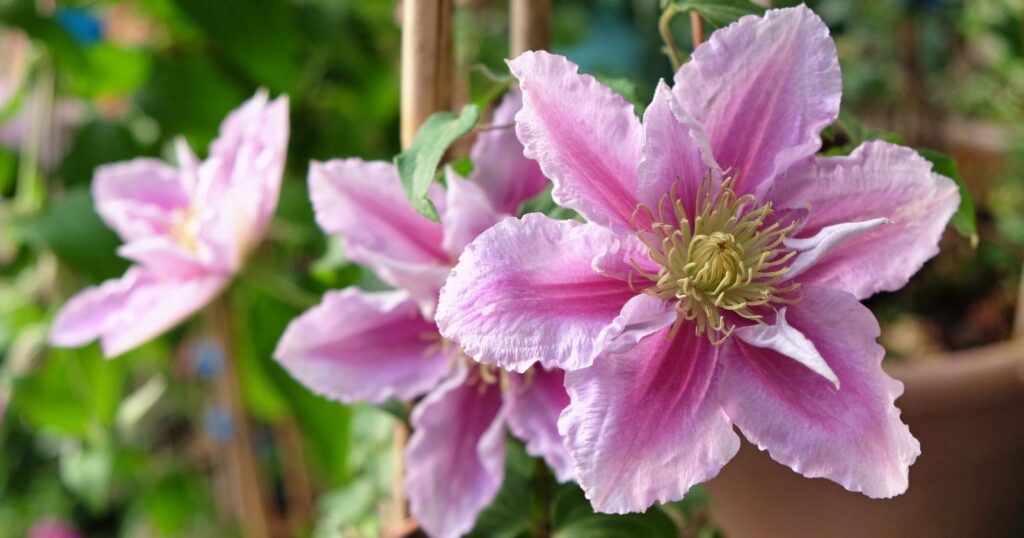
Scientific Name: Clematis
- Sun Exposure: Full sun, partial sun
- Height When Mature: 6 – 10 feet
- Soil pH: Alkaline, Neutral
- Plant Zone: 4 – 11
There are over 300 species of Clematis, and even more hybrids and they are divided into 12 groups. Their climbing habit and delicate nature mean that they need support. So give them something to climb such as a trellis or a wall if you don’t want them to bully other plants.
The Early Large-Flowered Clematis group includes many bold, punchy pink blooms. The flowers are large, up to 10 inches across in some cases, and star-shaped. Some are frilly, and some are stripped, usually with a contrasting-colored center. Outstanding pink Clematis in this group includes ‘Asao’, ‘Nelly Moser’, and ‘Rebecca’.
Columbine
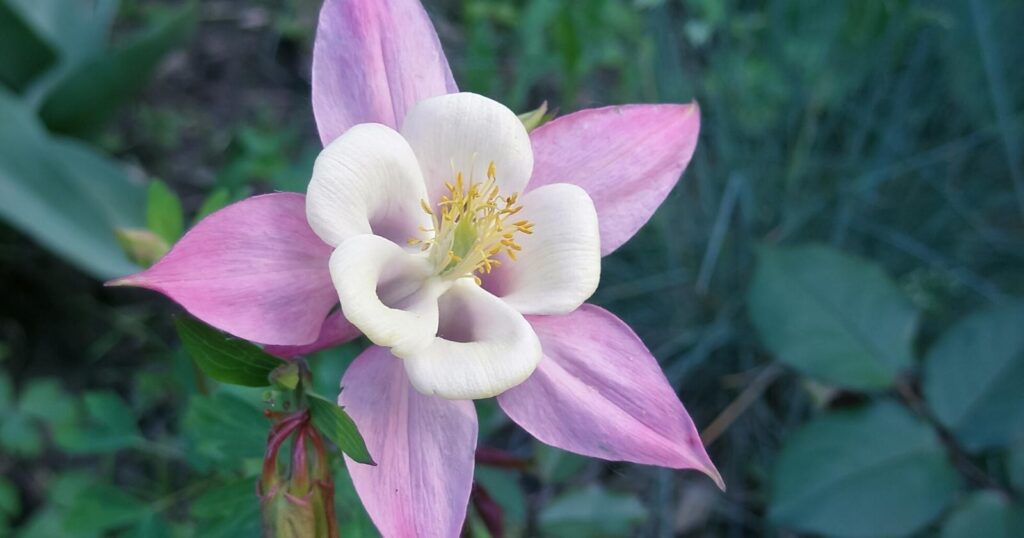
Scientific Name: Aquilegia
- Sun Exposure: Full sun, partial sun
- Height When Mature: 1 – 3 feet
- Soil pH: Acid, Alkaline, Neutral
- Plant Zone: 3 – 9
Also commonly known as Granny’s Bonnet, it is a versatile perennial that produces bell-shaped flowers and wonderful lacy foliage. They bloom for several weeks from mid-spring through to the summer. It is important to pick the right Columbine for your space as species vary in height. With some starting at 4 inches and others reaching 3 feet.
Columbine is an easy-going plant, but it dislikes poorly drained soils, and never allow the soil to dry out either. Columbines only last for around 3 years, but they self-seed easily. Meaning that they will maintain their presence in your garden.
Common Foxglove
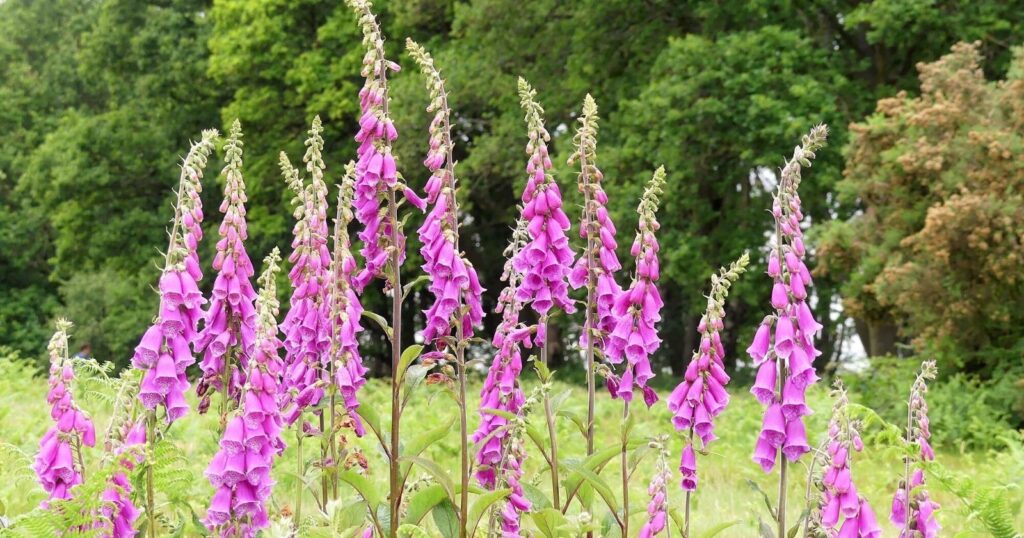
Scientific Name: Digitalis purpurea
- Sun Exposure: Full sun, partial sun
- Height When Mature: 3 – 4 feet
- Soil pH: Acid, Alkaline, Neutral
- Plant Zone: 5 – 9
The Common Foxglove is a cottage classic favorite. It is a short-lived perennial lasting a few years in zones 5 – 9, and will self-seed easily too. Meaning that new plants will come back year after year. It produces tall spires of funnel-shaped flowers often speckled with different colors. This flower is a hummingbird magnet.
Pretty pink Foxglove varieties include ‘Camelot Rose, ‘Candy Mountain’, and ‘Dalmatian Peach’. Foxgloves look best when planted in groups of at least 3, and they need moist and well-drained soils to thrive.
Coneflower
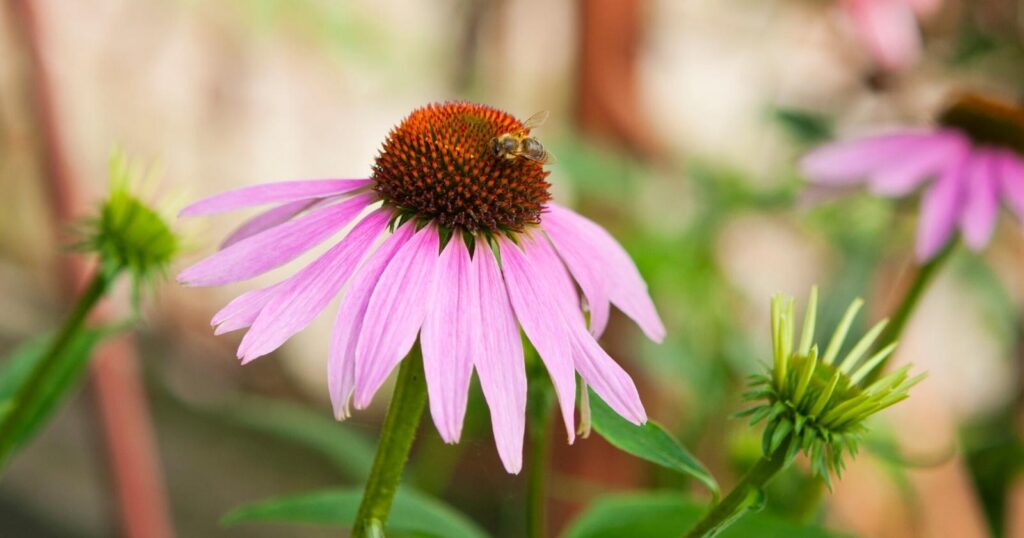
Scientific Name: Echinacea
- Sun Exposure: Full sun
- Height When Mature: Up to 4 feet
- Soil pH: Acid, Alkaline, Neutral
- Plant Zone: 3 – 10
If you’re seeking a native traditional pink perennial, look no further than the Coneflower. Echinacea is a genus of hardy flowers in the daisy family. They are found in eastern and central North America in wooded areas and prairies. They boast large, showy flowers that sit on top of tall, stiff stems.
For bold pink color consider award-winning pink Echinaceas such as ‘Magnus’ and ‘PowWow Wild Berry’. They are long bloomers starting in spring sometimes lasting until the first frost. They prefer dry to medium moisture soils and will self-seed if seed heads are left.
Coral Bells
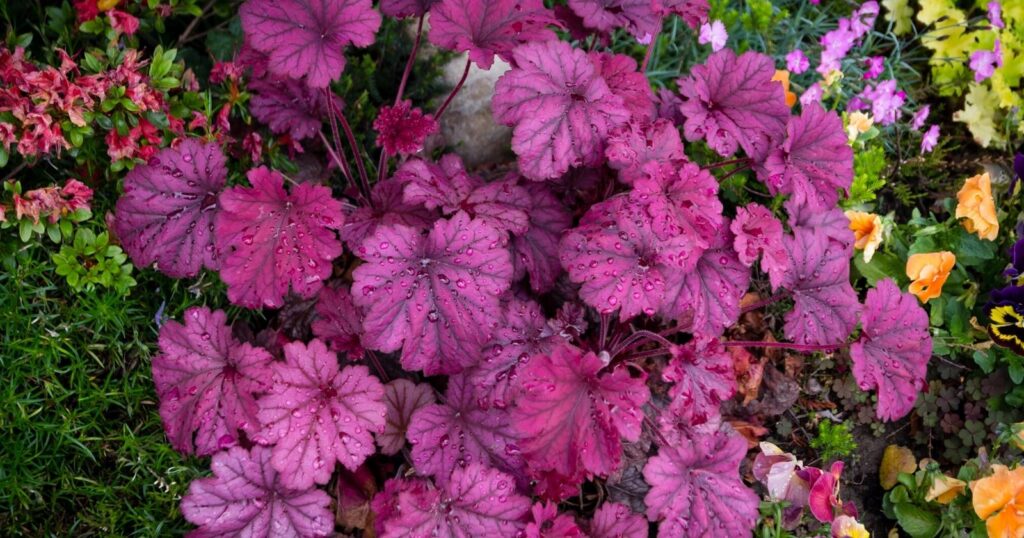
Scientific Name: Heuchera
- Sun Exposure: Full sun, partial shade, full shade
- Height When Mature: 2 feet
- Soil pH: Acid, Neutral
- Plant Zone: 4 – 9
Coral Bells bloom at the start of summer for several weeks. ‘Timeless Glow’ is a wonderful pink choice. It performs well in all conditions but thrives best in dry shade once it is established. It is an easy-going plant that needs constantly moist, but well-drained soil.
Coral Bells is a clump-forming, evergreen plant with seasonal-changing foliage. Thin but sturdy stems rise from the foliage adorned with small but vibrant pink flowers. It is attractive to all pollinating insects and hummingbirds and looks great in containers.
Daylily
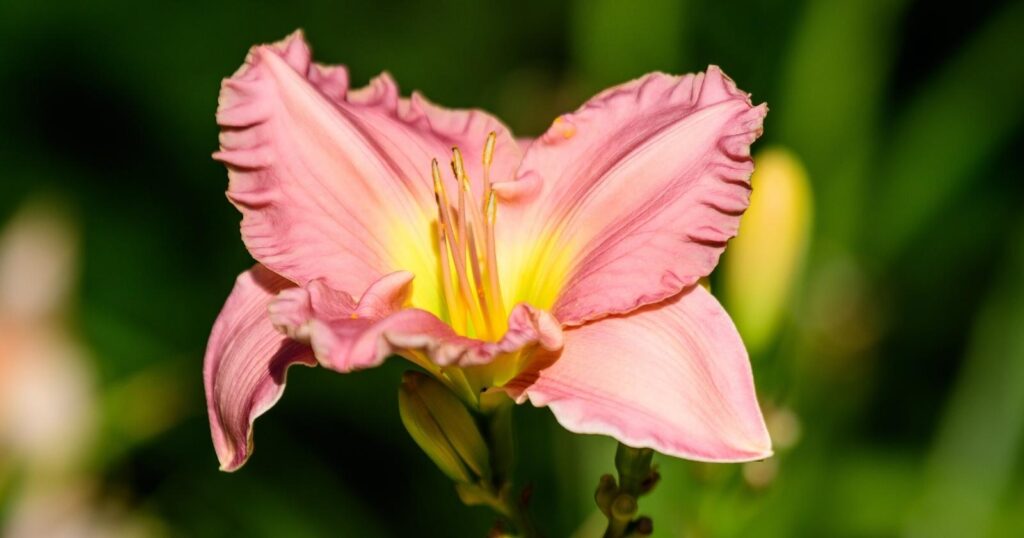
Scientific Name: Hemerocallis
- Sun Exposure: Full sun, partial sun
- Height When Mature: Up to 3 feet
- Soil pH: Acid, Alkaline, Neutral
- Plant Zone: 3 – 9
Daylilies are described by many as the ‘perfect perennial’. Why? Because they are beautiful, easy to care for, heat and drought-tolerant, and easy to grow. Plus, many of them are heavily fragrant. Trumpet-shaped flowers open daily to expose wonderful colors, patterns, and textures.
There are over 60,000 Hererocallis cultivars to choose from. You can find pink lilies that bloom early, mid, and late seasons. By picking one from each you can ensure long-lasting pink in your garden. ‘Cherry Cheeks’, ‘Dragons Eye’, ‘Lies and Lipstick’, and ‘Rosy Returns’ are all stunning and award-winning pink Daylilies to consider.
Elephant’s Ears
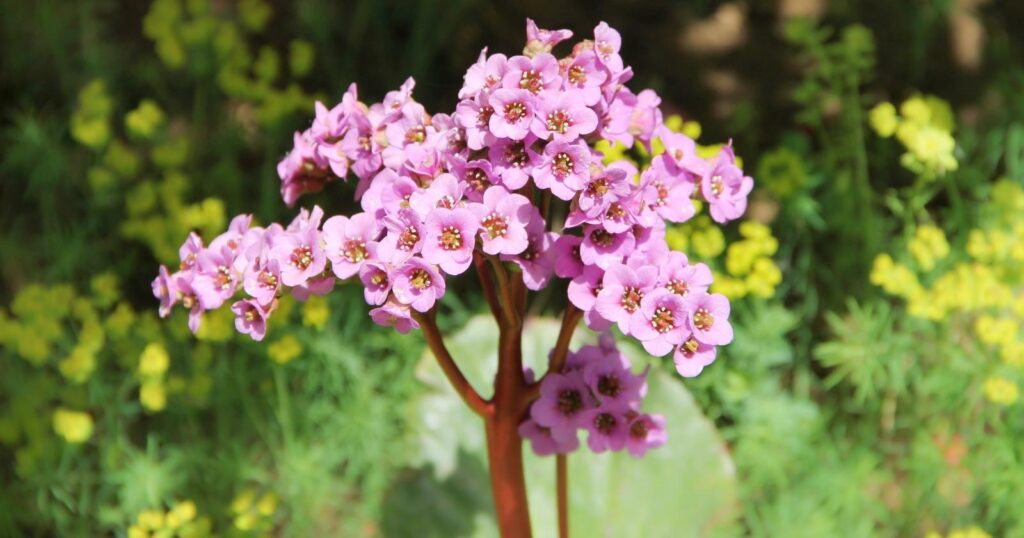
Scientific Name: Bergenia
- Sun Exposure: Full sun, partial sun
- Height When Mature: Up to 2 feet
- Soil pH: Acid, Alkaline, Neutral
- Plant Zone: 3 – 9
Elephant’s Ears is a clump-forming evergreen perennial plant that boasts clusters of small showy flowers. Elephant’s Ears can tolerate a wide range of soils, including poor soils. Although it does prefer humus-rich, moist well-drained soil.
There are several Bergenias to choose from, and almost all of them are pink. ‘Eroica’ is an award-winning pink plant of merit as it has great frost resistance, interesting foliage, and prolific blooms. The foliage also turns a shade of red in the winter for an extended pink punch.
English Rose
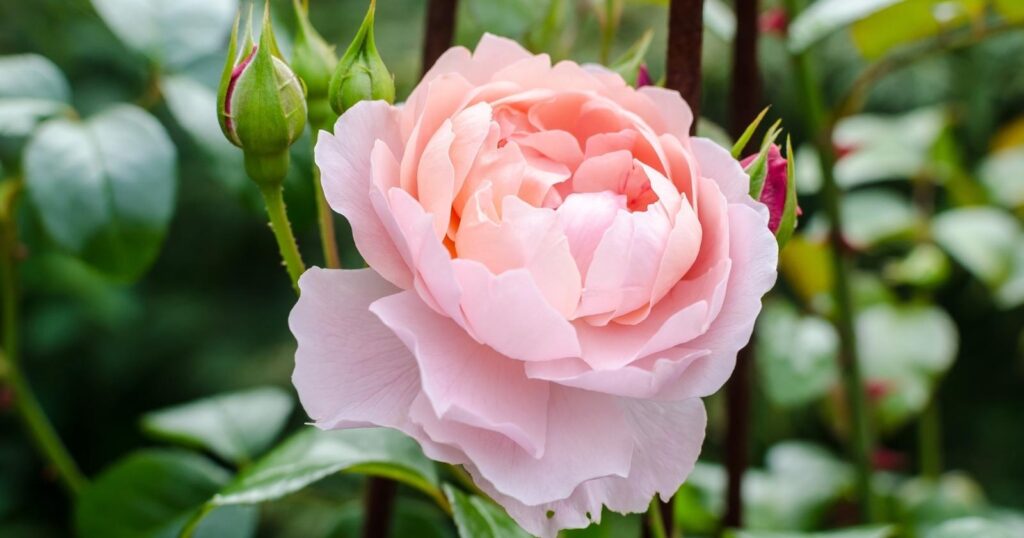
Scientific Name: Rosa
- Sun Exposure: Full sun, partial sun
- Height When Mature: Up to 10 feet
- Soil pH: Acid, Alkaline, Neutral
- Plant Zone: 4 – 10
There are over 150 Rose species and thousands of hybrids to choose from. It’s important to do your research when picking which type of Rose you want. English Roses are extremely popular because they combine the favored rosette form and the sweet fragrance of traditional roses with the color variety and repeat flowering habits of modern roses.
Most English Roses are pink, and some of the most popular include ‘A Shropshire Lad’, ‘Gertrude Jekyll’, and ‘Princess Anne’. Be sure to plant your English Rose somewhere where its strong scent can be enjoyed, either by a patio or doorway or along a path. They need moist and well-drained soil to thrive from spring to fall.
False Goat’s Beard
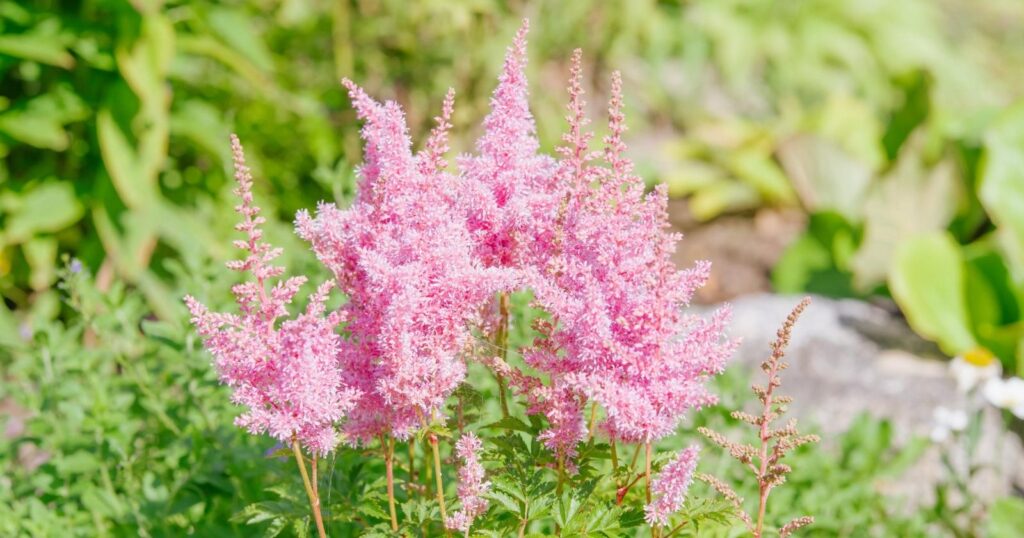
Scientific Name: Astilbe
- Sun Exposure: Partial sun
- Height When Mature: Up to 4 feet
- Soil pH: Acid, Alkaline, Neutral
- Plant Zone: 4 – 9
Astilbe is a genus of around 25 reliable perennial species. Astilbes are renowned for their tall, fluffy plumes that sit above fern-like foliage. They are ideal for areas that benefit from dappled shade. Astilbes range in colors including white and purple. But the pink Astilbes are considered by many to be the most striking and vibrant.
Astilbe is a midsummer bloomer that peaks when other perennials start to fade. Meaning you can extend your garden’s color show. Astilbes like moist soil so don’t let it dry out. It is a magnet for bees and butterflies, and some Astilbes are fragrant too.
Fuchsias
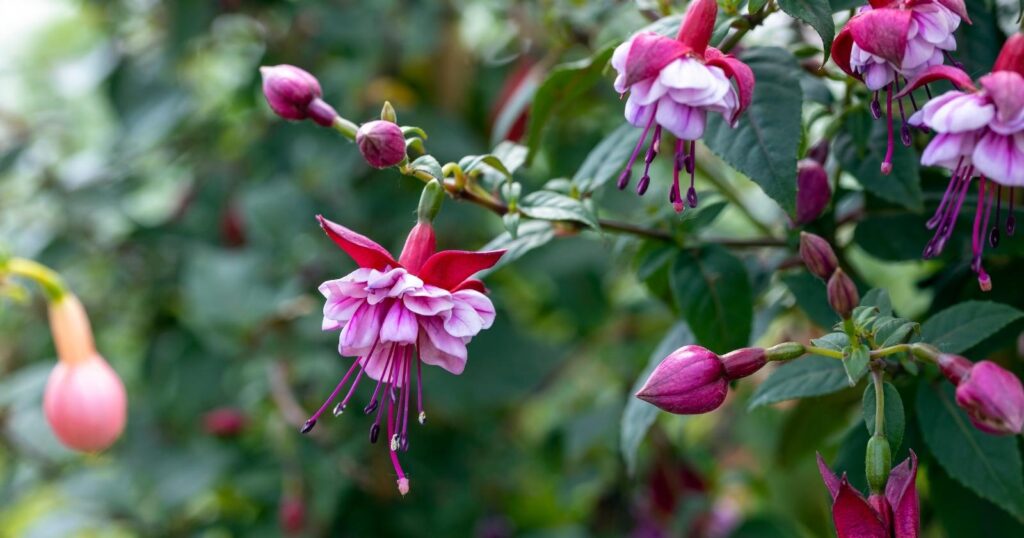
Scientific Name: Fuchsia
- Sun Exposure: Full sun, partial sun
- Height When Mature: Up to 6 feet
- Soil pH: Acid, Alkaline, Neutral
- Plant Zone: 6 – 11
There are approximately 110 species of Fuchsia to choose from, and thousands of cultivars. Some are hardy and others half hardy. Some grow in a trailing habit, making them best suited to hanging baskets. And others grow in an upright bushy habit, making them ideal for beds and containers.
Whatever species you pick, you are guaranteed luscious shades of pink from spring through to the first frost. From pastel pink to hot magenta, many combined with white, purple, or different pinks, the blooms are very showy. Butterflies and hummingbirds love them, and they are super easy to care for. Keep their soil moist and well-drained.
Garden Phlox
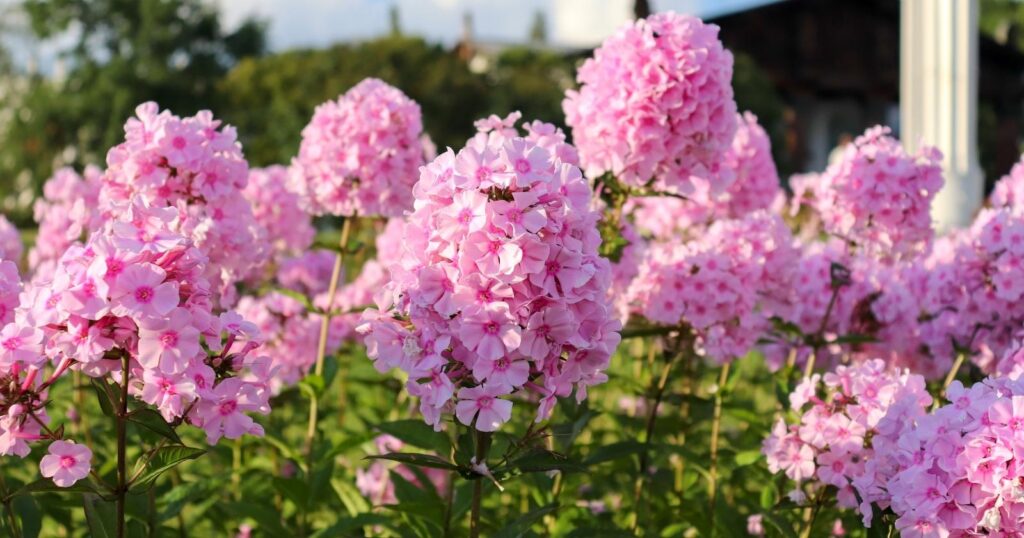
Scientific Name: Phlox paniculata
- Sun Exposure: Full sun, partial sun
- Height When Mature: 2 – 4 feet
- Soil pH: Acid, Alkaline, Neutral
- Plant Zone: 4 – 8
Garden Phlox is known for its pretty star-shaped perennials, and many of the varieties are pink. Meaning that you’ve got a few to choose from. ‘Eva Culllum’ is an award-winning option, and ‘Candy Stripe’ is a striking option thanks to the bold pink strip on each petal.
The sweetly fragrant flowers attract all pollinating insects and hummingbirds. It needs moist soils to thrive, and plenty of air circulation. They come back year after year and self-seed freely. Phlox looks great in borders and in containers as an eye-catching accent plant.
Garden Pink
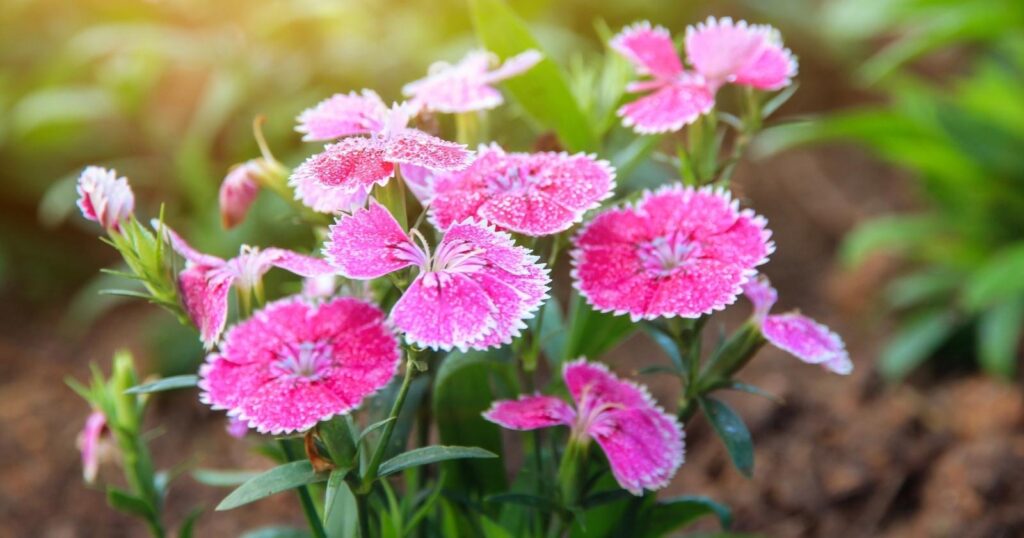
Scientific Name: Dianthus
- Sun Exposure: Full sun, partial sun
- Height When Mature: Up to 2 feet
- Soil pH: Alkaline, Neutral
- Plant Zone: 3 – 10
Sometimes known as just Pink, this perennial flower was bound to appear on this pink perennial list. There are many varieties of Dianthus, meaning it’s crucial to select the correct one for your space. Ranging from 4 inches to 3 feet tall, there’s a lot of choice in the Dianthus family.
‘Candy Floss’, ‘Moulin Rouge’, and ‘Whatfield Magenta’ are prized pink-colored Dianthus. Most Dianthus are also sweetly-fragranced, so be sure to plant them where their smell can be appreciated. Garden Pink has average water needs and does well in rock gardens and at the front of borders.
Great Masterwort
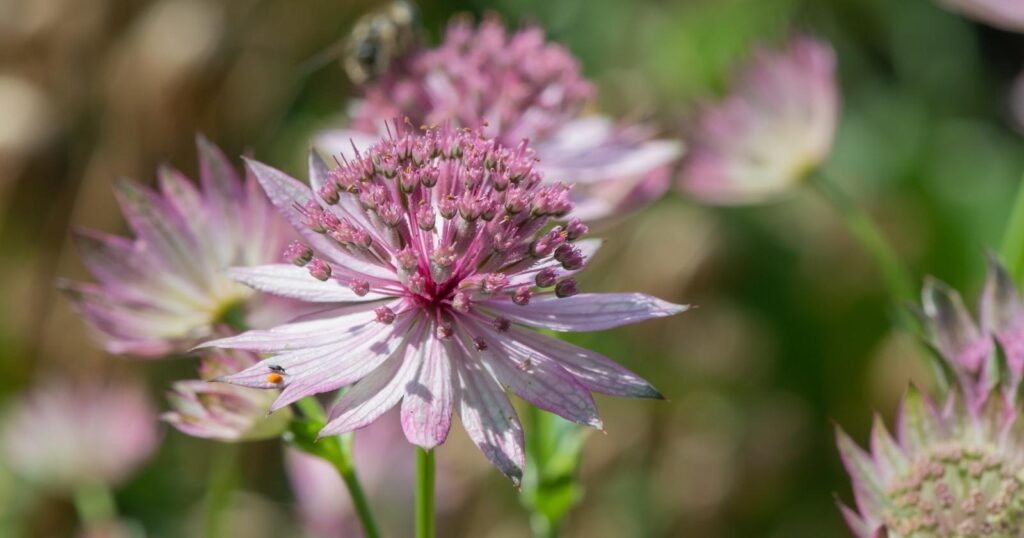
Scientific Name: Astrantia major
- Sun Exposure: Full sun, partial sun
- Height When Mature: Up to 3 feet
- Soil pH: Acid, Alkaline, Neutral
- Plant Zone: 4 – 8
Astrantia major is the most popular pick from the Astrantias family. It blooms from late spring to early summer and produces spectacular blooms. Tiny pink flowers crowd together to form a dome-shaped bloom, much like a cushion full of pins. When it is happy, Masterwort continues to bloom sporadically throughout the summer.
It is a relatively carefree plant, but it does need medium to wet, well-drained soil to do its best. It also isn’t a fan of hot and humid climates. The little pins attract butterflies and are sure to wow your garden visitors. ‘Roma’ is an RHS award winner.
Hollyhock
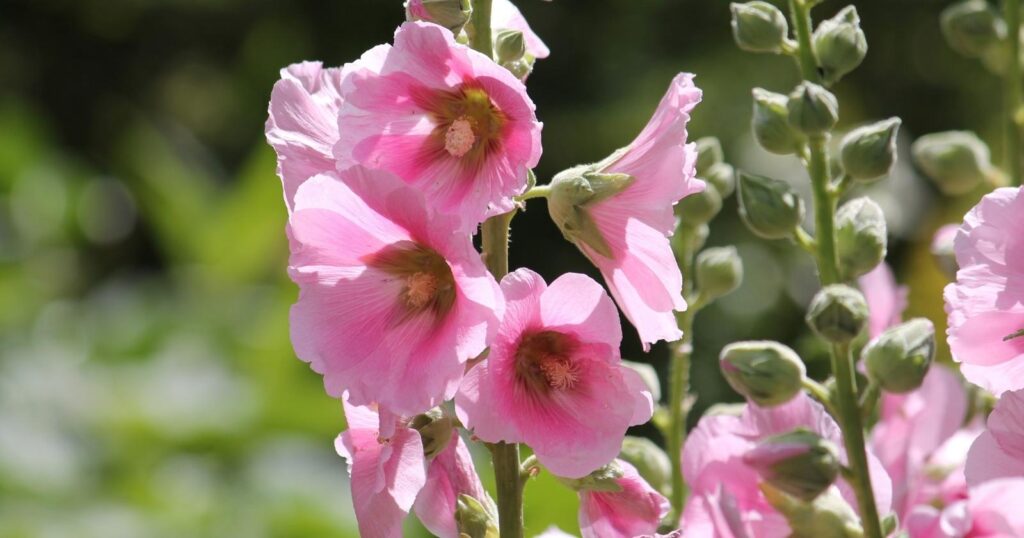
Scientific Name: Alcea rosea
- Sun Exposure: Full sun
- Height When Mature: Up to 8 feet
- Soil pH: Acid, Alkaline, Neutral
- Plant Zone: 3 – 9
Hollyhock is another cottage classic that never fails to impress visitors, including butterflies and hummingbirds. It provides architectural height to your garden, and it needs support to prevent falling over. Although it is a short-lived perennial, it self-seeds easily meaning it will always maintain its spot in your garden.
Hollyhock flowers from mid to late summer and blooms from the bottom up. It needs average to medium moisture and well-drained soil. ‘Fiesta Time’ and ‘Radiant Rose’ are strong pink contenders to consider.
Hummingbird Mint
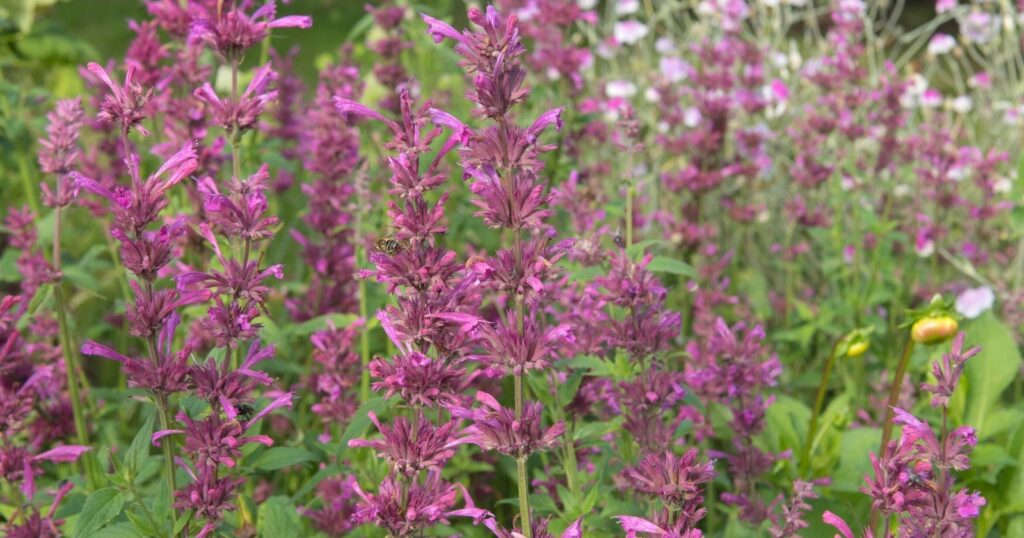
Scientific Name: Agastache
- Sun Exposure: Full sun
- Height When Mature: Up to 3 feet
- Soil pH: Acid, Alkaline, Neutral
- Plant Zone: 5 – 10
Hummingbird Mint is an impressive perennial that produces bold and wide flower spikes sprinkled with tonnes of small flowers. It is a clump-forming plant, and its foliage is usually dark emitting a licorice scent. It is a relatively carefree plant, but its soil must be well-drained if you want high-performing blooms.
From spring to fall Hummingbird Mint will provide you with all the pink your beds and borders could wish for. Plant en masse for the best visual impact, or as an accent plant in a pot. It grows tall and wide, so allow it plenty of space.
Japanese Iris
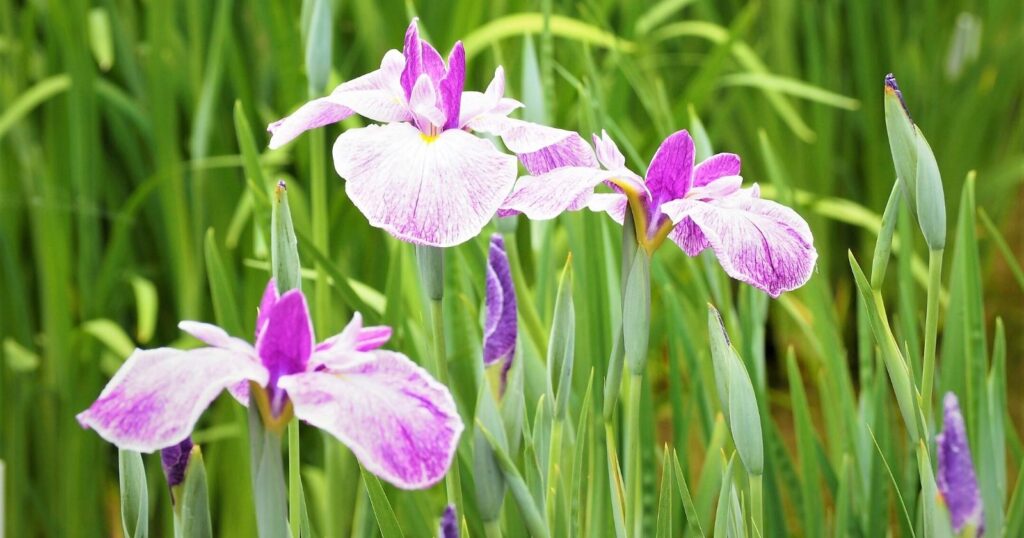
Scientific Name: Iris ensata
- Sun Exposure: Full sun, partial sun
- Height When Mature: Up to 3 feet
- Soil pH: Acid, Neutral
- Plant Zone: 4 – 9
For a more delicate pink pastel punch, why not choose a Japanese Iris. ‘Pink Frost’ is a spectacular choice here. With its ruffled petals and contrasting yellow throat, it adds a dramatic feel to any landscape. It produces sword-like leaves and tall stems carrying the blooms. Vertical interest is easily achieved with this pick.
Japanese Irises love water and moist-retentive soils. During the summer they thrive in standing water, so make a great choice for water gardens. However, they cannot tolerate it in the winter so it’s best to keep them in pots so that you can move them around the garden.
New England Asters
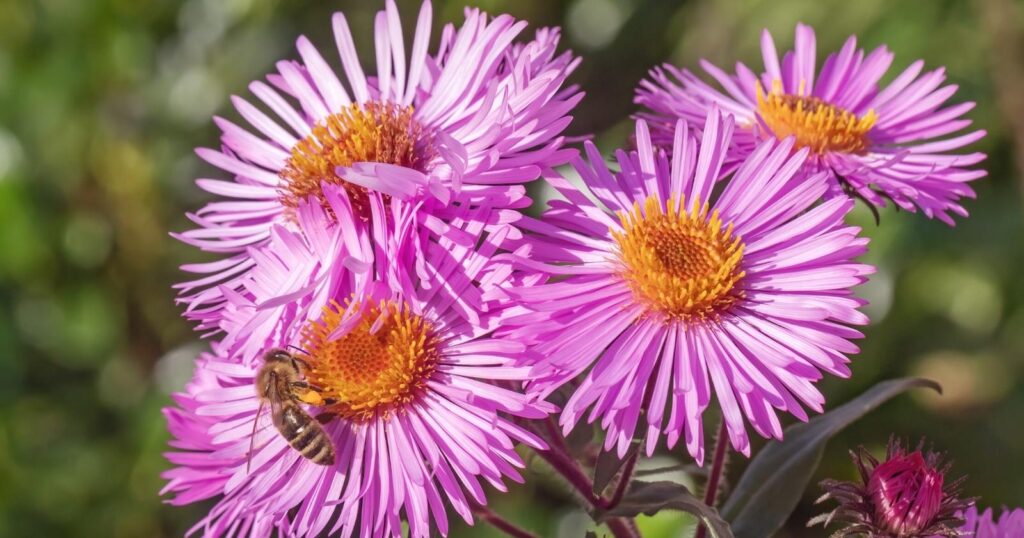
Scientific Name: Aster novae-angliae
- Sun Exposure: Full sun, partial sun
- Height When Mature: Up to 6 feet
- Soil pH: Acid, Alkaline, Neutral
- Plant Zone: 3 – 9
New England Asters are a must for those looking for late-season pink hues. They are hardy perennials that grow vigorously. At heights of 6 feet, you should consider planting these at the back of your beds. It’s native to North America, long-lived, provides bright color all season long, and attracts birds and butterflies from afar.
These Asters produce multiple stems, each carrying bunches of blooms. During the night and when the sun is not shining, the blooms close. Opening back up when the sun reappears. It needs medium moisture soil to do well. ‘Harrington’s Pink’ is a top-performing cultivar.
Peony
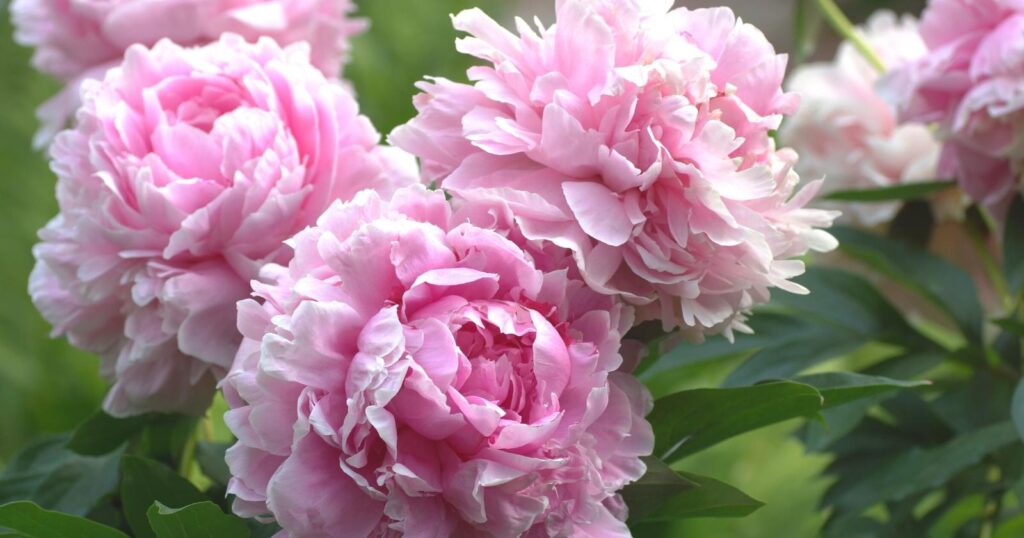
Scientific Name: Paeonia lactiflora
- Sun Exposure: Full sun, partial sun
- Height When Mature: Up to 3 feet
- Soil pH: Acid, Alkaline, Neutral
- Plant Zone: 3 – 8
Whether you’re looking for a hot pink hit or a delicate pink hue, Peonies come in all shades of pink. They also offer a variety of shapes and textures. From classic ruffled petals to more modern daisy-like shapes, there’s a Peony for every taste. Many are highly fragrant too.
‘Dr, Alexander Fleming’ is an award-winning favorite. It is a hardy perennial producing huge flowers with an extended bloom season. Peonies are low maintenance but they like medium moisture soils. The foliage changes color throughout the season and remains attractive until the first frost.
Peruvian Lily
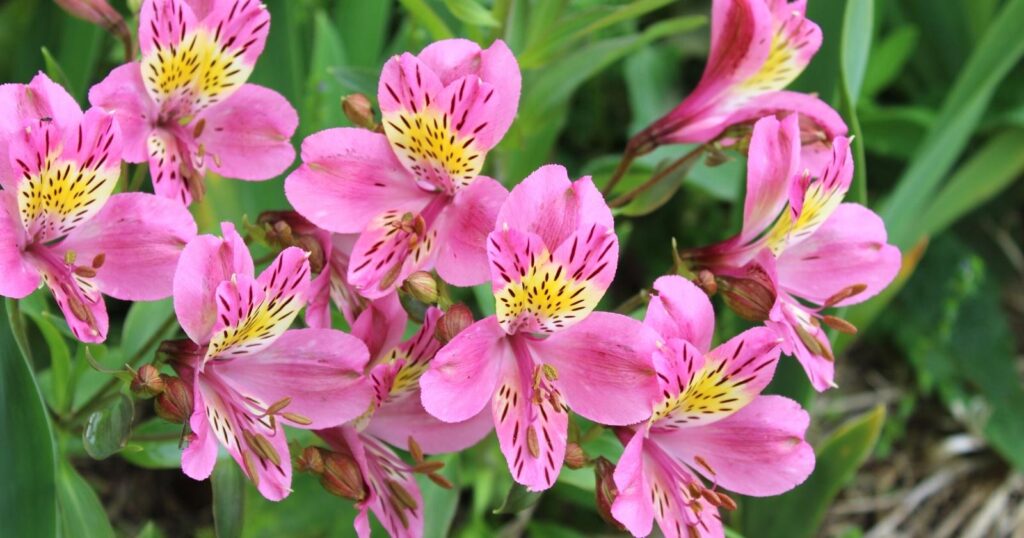
Scientific Name: Alstroemeria
- Sun Exposure: Full sun, partial sun
- Height When Mature: Up to 3 feet
- Soil pH: Acid, Alkaline, Neutral
- Plant Zone: 5 – 10
This is a perennial bulb that comes back year after year in the right conditions. Peruvian Lilies come in a variety of shades, with pastel pink and hot magenta included. Whatever shade you choose, they usually have pale yellow throats and dark-colored streaks. The lance-shaped dark-green leaves allow the blooms to pop.
Peruvian Lilies make a great border plant and a potting specimen. Adequate moisture is key to pretty blooms. They multiply easily if not kept in check. Butterflies love Alstroemeria, but contact may cause skin irritation.
Pink Tickseed
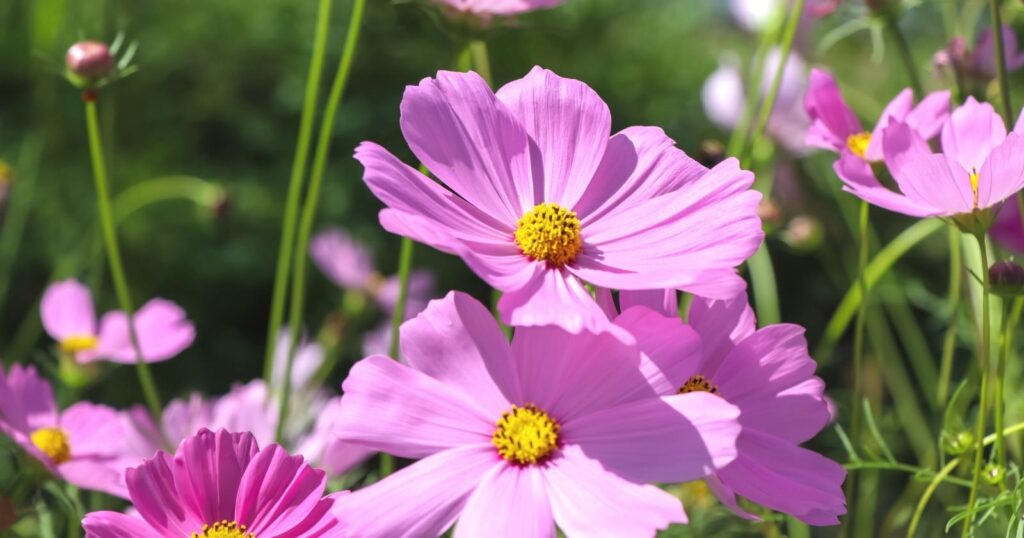
Scientific Name: Coreopsis rosea
- Sun Exposure: Full sun
- Height When Mature: 1 – 2 feet
- Soil pH: Acid, Neutral
- Plant Zone: 3 – 9
Pink Tickseed boasts 1-inch wide pink star-shaped flowers, each with a sunny center. Against the bright green grass-like foliage, these blooms stand out. This plant needs slightly acidic, sandy but consistently moist soil to do well. Other than that, it is fairly low maintenance and easily grown from seed.
Pink Tickseed blooms for months on end prolifically. Deadheading blooms will encourage more, however, this can be tedious and unnecessary considering how many there are. They look great in rock gardens or planted en masse for a stunning bright pink show.
Poppy Anemone
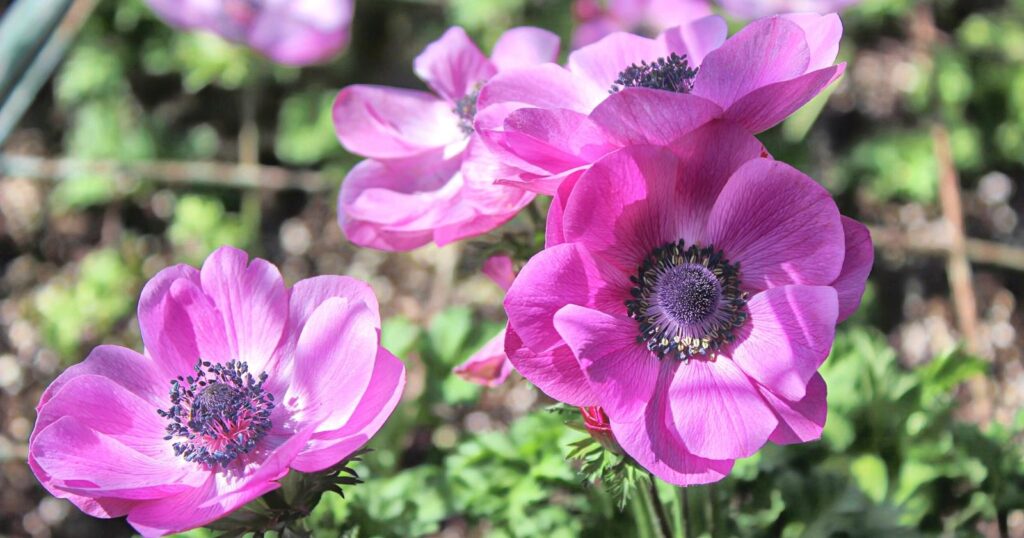
Scientific Name: Anemone coronaria
- Sun Exposure: Full sun
- Height When Mature: Up to 2 feet
- Soil pH: Acid, Alkaline, Neutral
- Plant Zone: 7 – 10
This is a bulbous perennial that comes back year after year once established. The poppy-like flowers are most popular as cut flowers but are becoming more popular with gardeners. They bloom in mid to late spring and last for many weeks. They are very easy to grow making them ideal for beginners and returning yearly.
Poppy Anemones have five velvety petals with a dark-domed center. They come in a wide array of colors. ‘Sylphide’ variety offers a splash of hot magenta to perennial beds and it can provide up to 18 flowers per plant. The fern-like foliage makes them pop even more. They needy sandy medium-moisture soils to thrive.
Sea Thrift
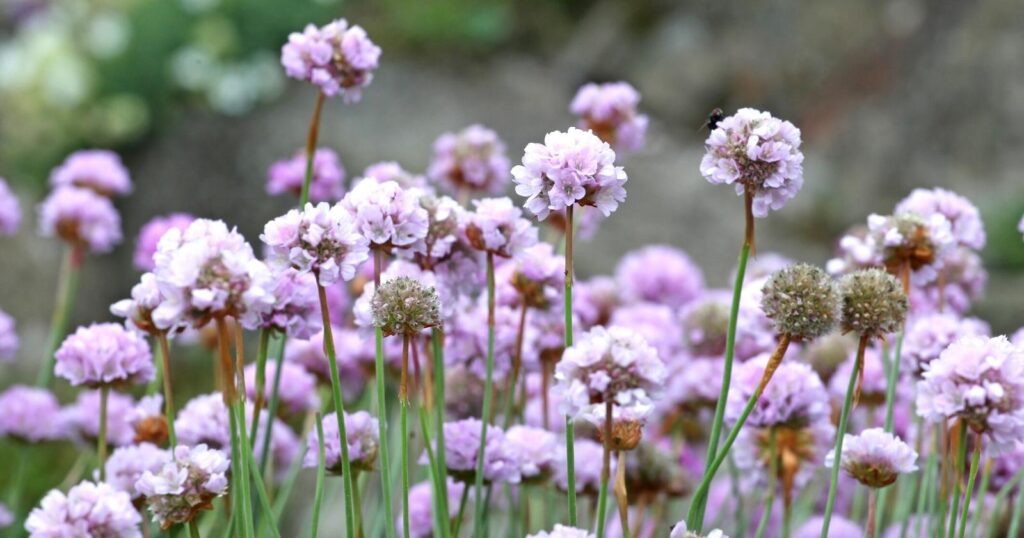
Scientific Name: Armeria maritima
- Sun Exposure: Full sun, partial sun
- Height When Mature: Up to 1 foot
- Soil pH: Acid, Alkaline, Neutral
- Plant Zone: 3 – 9
Sea Thrift is a great choice for coastal areas in need of a dash of pink. It is an evergreen perennial that grows in a clump-like habit. The foliage is rich green and grass-like. From there, clusters of rich pink flowers bloom from mid-spring. When happy, Sea Thrift has a sporadic blooming season in the summer.
Sea Thrift grows up to 1 foot tall, and it is a great option for edging and rock gardens. This flower likes dry, well-drained soils, and it does better in infertile, poor soils. It is a low-maintenance plant that spreads slowly needing little attention.
Verbena
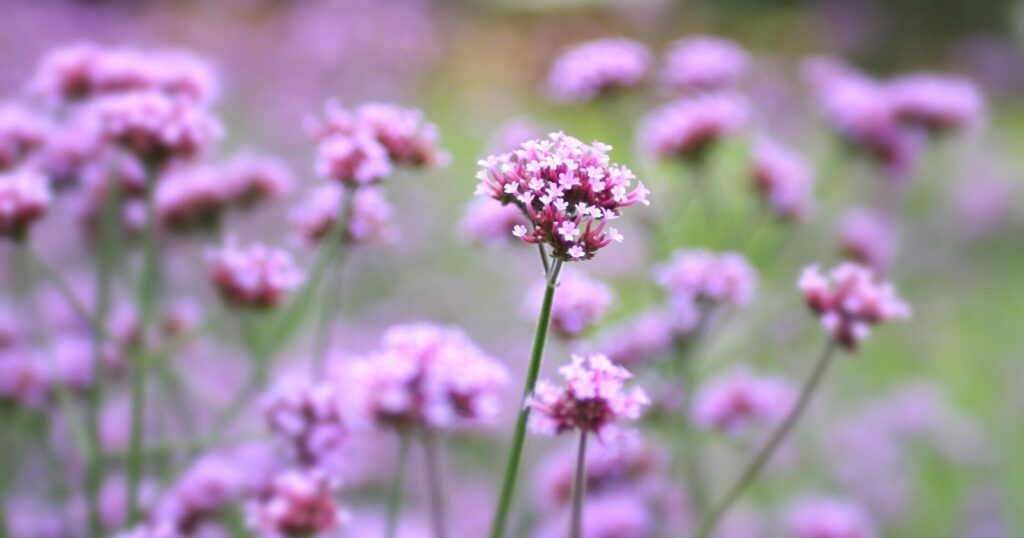
Scientific Name: Verbena
- Sun Exposure: Full sun, partial sun
- Height When Mature: Up to 1 foot
- Soil pH: Acid, Alkaline, Neutral
- Plant Zone: 3 – 11
Also commonly known as trailing Verbena due to its growth habit, this is a wonderful vigorous plant. It makes a great addition to any garden seeking an endless carpet of pink. It produces clusters of small flowers that bloom from summer through to the first frost. The blooms smother the foliage, providing endless color.
Verbena is attractive to butterflies but ignored by deer, and it is hardy against most pests, diseases, and mildew. It is also heat and drought-tolerant, making it a great contender for gardeners seeking an easy-going plant. Some varieties self-seed meaning that they hold their spot in the garden despite being a tender perennial. It performs best in zone 8.
Yarrow
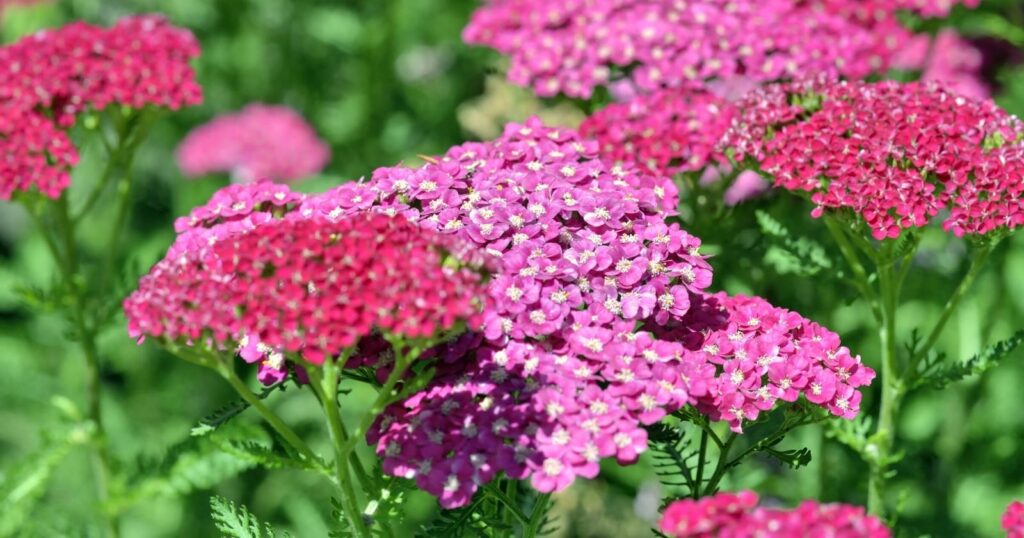
Scientific Name: Achillea millefolium
- Sun Exposure: Full sun
- Height When Mature: Up to 5 feet
- Soil pH: Acid, Alkaline, Neutral
- Plant Zone: 3 – 9
Yarrow produces an abundance of flower clusters that grow up to 8 inches wide. The flower discs bloom for weeks from early summer, sometimes into fall. Most Yarrow species have finely cut grass-like foliage that is highly fragrant. Yarrow is a must-have for gardeners wanting to attract butterflies and other pollinators.
Yarrow is easy to care for and is drought and heat tolerant, and hardy against pests and diseases. It likes dry to medium-moisture soils. Yarrow is prized for being a great option for bouquets and dried floral arrangements. Particularly pretty pink species include ‘Strawberry Seduction’, ‘Pretty Belinda’, and ‘Pink Grapefruit’.
Wrap Up
Flowers don’t come much better than pink perennials. Whether it is a hot magenta hue or delicate pink pastels, there is a shade to suit every gardener. Some trail, some grow upright, and some spread all over the shop. But each one comes back year after year in the right conditions. We hope you have found the perfect pink perennial somewhere in our guide.

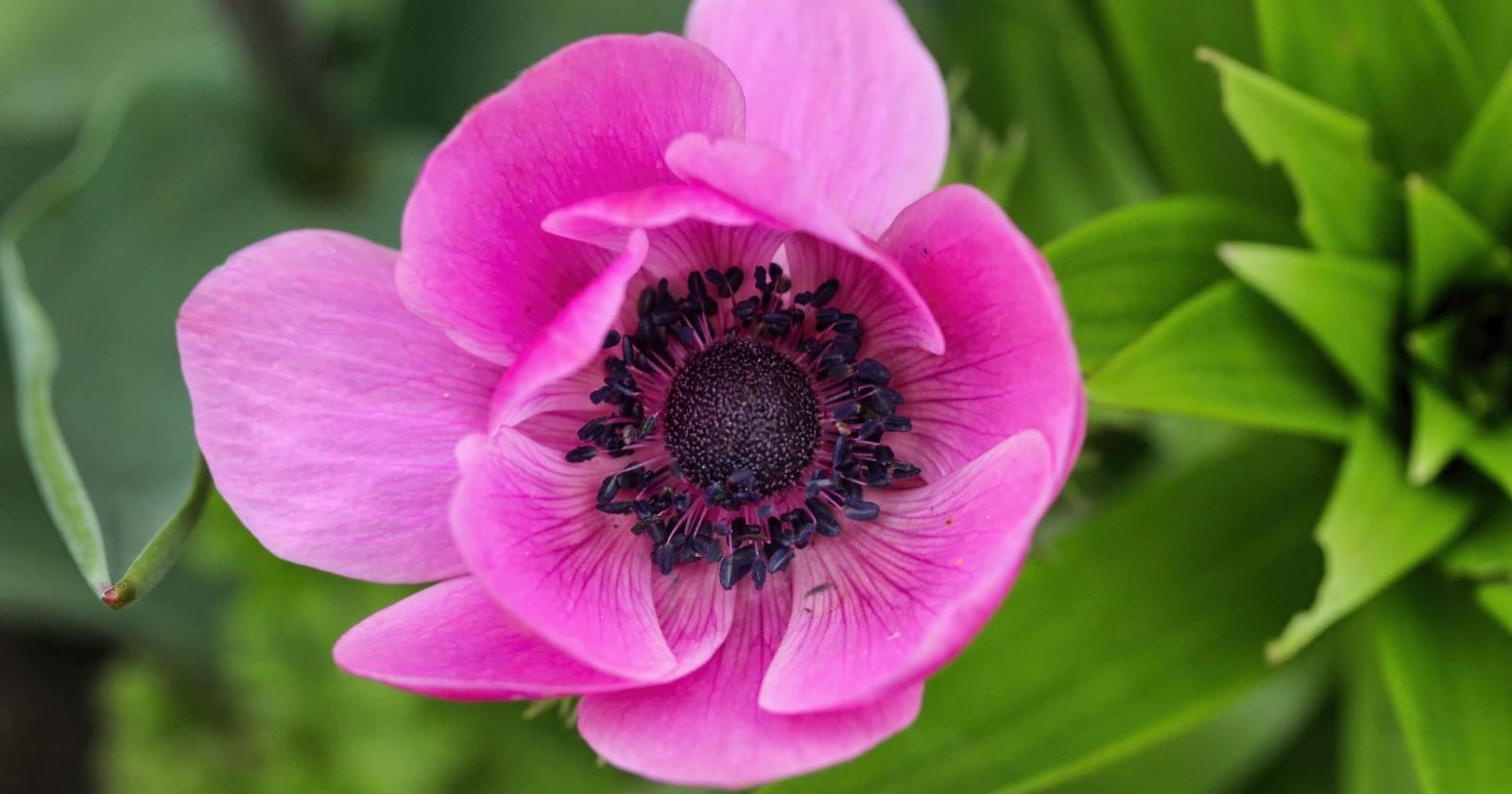
Leave a comment